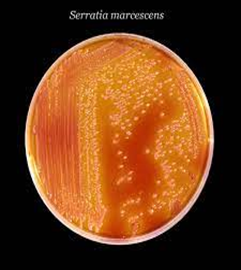Please click the frequently asked questions below for further information and IPC precautions required:
-
What is Serratia marcescens?
Serratia marcescens, a member of the Enterobacteriaceae family, is an important cause of invasive infections in neonatal intensive care units (NICUs), with significant associated morbidity and mortality.
Serratia marcescens causes infections such as pneumonia, urinary tract infection, wound infections and bacteraemia.
Risk factors for nosocomial infection of neonates include; low birth weight (<1500g), premature delivery, use of invasive devices, prolonged hospital stay and intensive care, prolonged use of antibiotics and maternal infection prior to delivery.
Death has also been reported in infants with severe conditions and/or congenital malformations, meningitis and septicaemia.

-
How does it spread?
It is able to survive in moist nosocomial environments and colonize the gastrointestinal tract of neonates.
Outbreaks of Serratia marcescens infections in NICUs have been widely documented. In many of these outbreaks, no point source was identified, and contaminated hands of healthcare workers are thought to have been the principal means of spread.
It is a Contact Spread organism. Transmission is possible from contact with colonised environmental sources or the skin of colonised individuals.
-
What are the symptoms of Serratia marcescens?
It is an opportunistic pathogen: while it can cause minor infections in healthy people, severe infections usually only occur in high risks patients such as Neonates.
-
Why is this important?
If NIAS staff are aware that the patient has a suspected or confirmed case this should be communicated to the Control Room (Emergency or Non-emergency as appropriate) and the staff in the receiving unit when transferring the patient to ensure effective patient care and management.
This is particularly essential if the patient is being admitted to Neonatal Unit.
-
IPC Precautions
- Standard Precautions should be used.
- Contact Precautions should be used if the patient is a Neonate.
- Hand Hygiene should be completed as per the 5 moments in line with usual practice.
- Eye protection should be risk assessed for any concern regarding a splash risk.
- Gloves and Aprons should be risk assessed and worn if contact with the patient’s blood or bodily fluids.
- Laundry should be treated as per usual policy.
-
What cleaning is required?
All equipment and the ambulance should have an in-between patient clean, paying particular attention to touch points.
-
Do staff need prophylaxis or follow up?
No staff follow up required.




